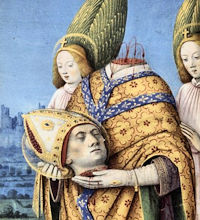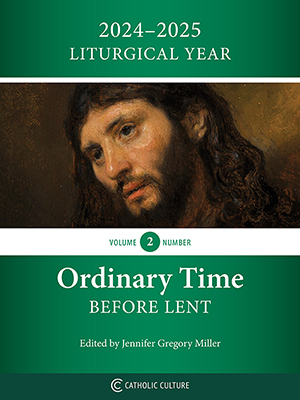Ordinary Time: October 9th
Optional Memorial of St. Denis, bishop and martyr and companions, martyrs; St. John Leonardi, priest
Other Commemorations: St. Louis Bertrand, Priest (RM) ; Other Titles: Denys; Dionysius; John Leonard; John Newman
» Enjoy our Liturgical Seasons series of e-books!
St. John Leonardi (1543-1609), a zealous Italian apostle, founded the congregation of the Mother of God, whose priest-members traveled throughout Tuscany urging the people to a stronger interest in their religion. Fr. John Leonardi longed to convert pagans, but his spiritual director, St. Philip Neri, told him to remain in Italy. So instead he founded a seminary in Rome to train young men for the priesthood from all the mission lands.
St. Denis, a third-century apostle of Gaul, and now one of the "Fourteen Holy Helpers" became first bishop of Paris. He suffered martyrdom there, together with his priest Rusticus and his deacon Eleutherius.
These feasts are celebrated today both in the Ordinary Form and the Extraordinary Form of the Roman Rite.
St. Denis
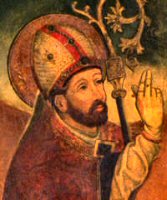 St. Denis was born in Italy. In 250 he was sent to France with six other missionary bishops by Pope Fabian. Denis became the first bishop of Paris. He was beheaded in 258 with the priest Rusticus and the deacon Eleutherius at Catulliacum, now Saint-Denis. One of the many legends about his torture and death was that his body carried his severed head some distance from his execution site. St. Denis is one of the Fourteen Holy Helpers who was invoked particularly in the Middle Ages against the Black Plague. See August 8 for more information.
St. Denis was born in Italy. In 250 he was sent to France with six other missionary bishops by Pope Fabian. Denis became the first bishop of Paris. He was beheaded in 258 with the priest Rusticus and the deacon Eleutherius at Catulliacum, now Saint-Denis. One of the many legends about his torture and death was that his body carried his severed head some distance from his execution site. St. Denis is one of the Fourteen Holy Helpers who was invoked particularly in the Middle Ages against the Black Plague. See August 8 for more information.
Patronage: against frenzy; against strife; against headaches; against diabolical possession; against rabies; against hydrophobia; possessed people; France; Paris, France
Symbols and Representation: beheaded bishop carrying his head — sometimes a vine growing over his neck; mitered head in his hand or on book; white chasuble; tree or stake; sword; Our Lord with chalice and host
Highlights and Things to Do:
- Learn more about the Fourteen Holy Helpers and their historical context.
- Bake a French (or Parisian) pastry. Cooking with the Saints by Ernst Schuegraf has 3 recipes for St. Denis — St. Denis Turnovers, Saint Denis Tartlets and Brioche Saint-Denis (Praline Cake).
- Read more about St. Denis:
- See Christian Iconography for some images of St. Denis.
- St. Denis was beheaded c.258 at Montmarte (=mount of martyrs), with his corpse thrown in the River Seine. His followers recovered and buried later that night. The Basilica of St. Denis in Paris is said to have been built over the tomb of St. Denis.
St. John Leonardi
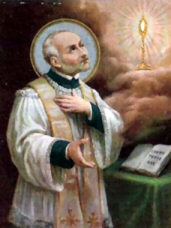 St. John Leonardi was born in Tuscany, Italy in 1541, during the time of upheaval in the Church due to Martin Luther. He studied to be a pharmacist, then became a priest. As a young priest, he devoted himself to teaching catechism to youths. In 1574, he founded the Order of the Clerks Regular of the Mother of God of Lucca, a congregation of diocesan priests. He suffered many tribulations for this work, including exile. His contemporary, St. Philip Neri, was a great friend and spiritual guide, and helped him particularly in his time of exile.
St. John Leonardi was born in Tuscany, Italy in 1541, during the time of upheaval in the Church due to Martin Luther. He studied to be a pharmacist, then became a priest. As a young priest, he devoted himself to teaching catechism to youths. In 1574, he founded the Order of the Clerks Regular of the Mother of God of Lucca, a congregation of diocesan priests. He suffered many tribulations for this work, including exile. His contemporary, St. Philip Neri, was a great friend and spiritual guide, and helped him particularly in his time of exile.
Gradually his influence as a champion of the Catholic faith against Protestantism became known throughout Italy. He later founded in Rome what became the Institute De Propaganda Fide (Society for the Propagation of the Faith) and the Confraternity of Christian Doctrine for the promotion of the Catholic Faith and the formation of missionaries. St. John Leonardi died at Rome, in 1609, the victim of his devoted care for the sick and plague-stricken.
Symbols and Representation: book (to symbolize rules of Congregation he founded); the coat of arms of the order is azure (blue), Our Lady Assumed into Heaven; and its badge and seal the monogram of the Mother of God in Greek characters.
Highlights and Things to Do:
- St. John promoted the teaching of the Catholic faith. We should study our faith, perhaps by reading the Catechism of the Catholic Church a little each day. Father Mike Schmitz's Catechism in a Year podcast is an excellent way to do this in bite-size pieces. See our review.
- Read more about St. John:
- Try to understand more deeply the historical context during St. John's life — he was fighting the effects of the Lutheran Reformation of the Church. Could we refute the teachings of Luther?
- Read Pope Benedict XVI's General Audience on St. John Leonardi.
- St. John's remains are located in Rome in the Santa Maria in Campitelli, also known as Santa Maria in Portico, enshrined under the altar of the Albertoni Altieri Chapel.
St. John Henry Cardinal Newman
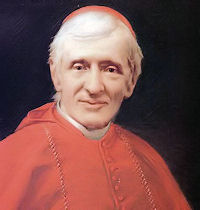 John Henry Newman, one of the great Christian intellectuals of the nineteenth century, was born in London in 1801. His spiritual quest having begun in adolescence, he later went on to study theology at Oxford University. Subsequently, he became an Anglican pastor, a fellow of Oriel College, and leader of the Oxford Movement which studied the Catholic roots of the faith in England. In 1842, while writing his "Essay on the Development of Christian Doctrine", he began to mature his conversion to Catholicism. He was admitted into the Catholic Church in 1845 and ordained a Catholic priest in Rome on 1 June 1847. Following his ordination, and with the encouragement of Pope Pius IX, he founded the first Oratory of St. Philip Neri in England. In 1852 he was appointed rector of the Catholic University of Dublin, Ireland, a post he held until 1854. Pope Leo XIII made him a cardinal in 1879 and he died in 1890 at the Oratory of Edgbaston. The process for his beatification began in 1958. Newman's miraculous intercession in the cure of Dean Jack Sullivan, who suffered a serious complaint of the spinal column, was officially recognized and approved by Benedict XVI in July 2009 and beatified on September 19, 2010. Pope Francis canonized John Henry Newman on October 13, 2019.
John Henry Newman, one of the great Christian intellectuals of the nineteenth century, was born in London in 1801. His spiritual quest having begun in adolescence, he later went on to study theology at Oxford University. Subsequently, he became an Anglican pastor, a fellow of Oriel College, and leader of the Oxford Movement which studied the Catholic roots of the faith in England. In 1842, while writing his "Essay on the Development of Christian Doctrine", he began to mature his conversion to Catholicism. He was admitted into the Catholic Church in 1845 and ordained a Catholic priest in Rome on 1 June 1847. Following his ordination, and with the encouragement of Pope Pius IX, he founded the first Oratory of St. Philip Neri in England. In 1852 he was appointed rector of the Catholic University of Dublin, Ireland, a post he held until 1854. Pope Leo XIII made him a cardinal in 1879 and he died in 1890 at the Oratory of Edgbaston. The process for his beatification began in 1958. Newman's miraculous intercession in the cure of Dean Jack Sullivan, who suffered a serious complaint of the spinal column, was officially recognized and approved by Benedict XVI in July 2009 and beatified on September 19, 2010. Pope Francis canonized John Henry Newman on October 13, 2019.
Highlights and Things to Do:
- Listen to the Catholic Culture podcasts on St. John Henry Newman and audiobooks of his writings.
- Episode 22: Newman’s Idea of a University—Paul Shrimpton
- Ep. 73—St. John Henry Newman’s Aesthetics—Fr. Guy Nicholls, Cong. Orat.
- There are 42 Audiobooks of St. John read by James Majeski, including Idea of a University:
- Trailer: Newman on the Fathers
- A Thanksgiving (poem)
- Christian Reverence
- Duties of Catholics Towards the Protestant View
- Fasting a Source of Trial
- Hope in God, Creator
- Keeping Fast and Festival
- Knowledge of God’s Will without Obedience
- Martyrdom
- Mental Sufferings of Our Lord in His Passion
- Moral Consequences of Single Sins
- Omnipotence in Bonds
- On the Annunciation
- On the Fitness of the Glories of Mary
- On the Name of Jesus
- Shrinking from Christ’s Coming
- The Cross of Christ the Measure of the World
- The Danger of Accomplishments
- The Glories of Mary for the Sake of Her Son
- The Idea of a University
Preface
Introductory
Theology a Branch of Knowledge
Bearing of Theology on Other Branches of Knowledge
Bearing of Other Branches of Knowledge on Theology
Knowledge Its Own End - The Lapse of Time
- The Patristical Idea of Antichrist
Pt. 1: The Times of Antichrist
Pt. 2: The Religion of Antichrist
Pt. 3: The City of Antichrist
Pt. 4: The Persecution of Antichrist - The Power of Prayer: 3 Poems
- The Reverence Due to the Virgin Mary
- The Salvation of the Hearer the Motive of the Preacher
- The Special Charm of Christmas
- Use of Saints’ Days
- Worship, a Preparation for Christ’s Coming Seasons
St. Louis Bertrand
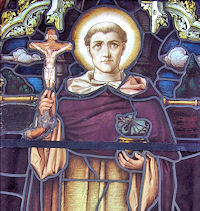 St. Louis Bertrand was born at Valencia, in Spain, in 1526, of the same family as St. Vincent Ferrer. In 1545, after severe trials, he was professed in the Dominican Order, and at the age of twenty-five was made master of novices, and trained up many great servants of God.
St. Louis Bertrand was born at Valencia, in Spain, in 1526, of the same family as St. Vincent Ferrer. In 1545, after severe trials, he was professed in the Dominican Order, and at the age of twenty-five was made master of novices, and trained up many great servants of God.
When the plague broke out in Valencia he devoted himself to the sick and dying, and with his own hands buried the dead. In 1562 he obtained leave to embark for the American mission, and there converted vast multitudes to the Faith. He was favored with the gift of miracles, and while preaching in his native Spanish was understood in various languages.
After seven years he returned to Spain, to plead the cause of the oppressed Indians, but he was not permitted to return and labor among them. He spent his remaining days toiling in his own country, till at length, in 1580, he was carried from the pulpit in the Cathedral at Valencia to the bed from whence he never rose.
He died on the day he had foretold-October 9, 1581.
—Excerpted from Lives of the Saints, by Alban Butler, Benziger Bros. ed. [1894]
Patronage: Caribbean vicariates; Colombia (declared by Pope Alexander VIII); Dominican novices
Symbols and Representation: chalice surmounted by a serpent; extinguishing a fire; holding a chalice occupied by a serpent (represents the attempts to poison him); holding a cross
Highlights and Things to Do:
- Find out more about St. Louis:
- See the statue of St. Louis on St. Peter's Basilica Colonnade.
- St. Louis was buried in the church of Saint Stephen in Valencia, Spain, but the church was burned in 1936 during the Spanish Civil War.


